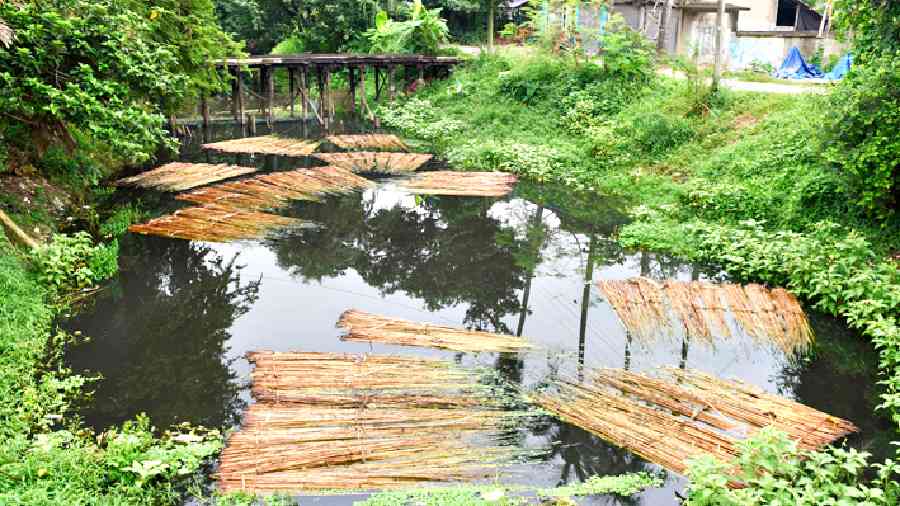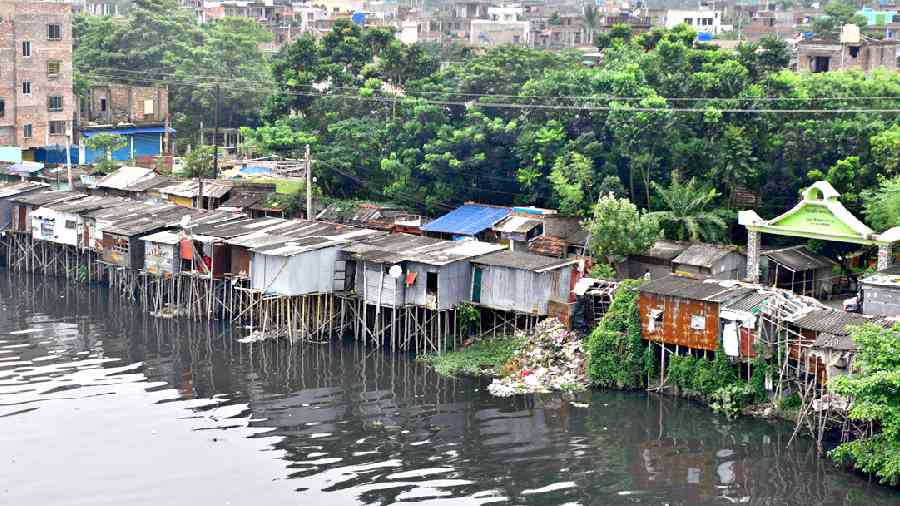The rain deficit so far this year has spared New Town from getting swamped.
Parts of the Bagjola canal that drains out water from all the township and large parts of Kolkata are still choked and, if anything, there has been a spurt in the number of huts that have been built on stilts sunk into the canal’s bed.
These encroachments have blocked the canal’s natural gradient, which is already in poor shape because of lack of dredging.
The Telegraph travelled along the banks of the Bagjola canal on Monday and in several places large islands formed by silt and garbage were clearly visible.
The New Town Kolkata Development Authority (NKDA) provides civic services to New Town and has several stormwater drainage pumping stations that drain rainwater into the canal.
The Bidhannagar Municipal Corporation also depends on this canal for stormwater drainage.
According to officials, both these bodies pumping out water into the canals has resulted in water breaching the canal banks.
To add to these two problems there is rampant dumping of garbage of which a large portion is plastic waste.
Large swathes of New Town were waterlogged for several days in September last year after the Bagjola canal breached its banks and water started flowing into residential blocks. the situation was such that several parts remained waterlogged for over a week.
On Monday, The Telegraph spotted rows of huts built on bamboo stilts even concrete pillars that have been sunk into the bed of the canal behind the Dr APJ Abdul Kalam Government College and Central Mall.
This 1.5km-long stretch behind the BA Block in Action Area I has witnessed a spurt in the number of huts along the canal, several residents of BA Block said.

The Rajarhat Pass canal near Action Area III of New Town
“There are not only huts but now people have also started building shops and fast food outlets along the banks. All the huts have come up on structures that have been built on concrete and bamboo stilts. Many of these are brick and mortar structures that have asbestos or brick-lined roofs and have been set up in the past few months,” said Swapna Pal Choudhury who stays in BA Block.
In a bid to prevent the canal from reaching its bank here the NKDA is setting up a concrete levee. “We are trying to raise the level of the canal bank to ensure that it does not overflow when it rains heavily,” said an NKDA official.
Another official said that the encroachments too were a huge problem and they have already notified the state irrigation department.
The irrigation department is in charge of dredging the Bagjola canal and according to a senior official of the department, they have started scooping out silt from parts of the canal.
The 38km-long Bagjola canal carries water from BT Road in Kamarhati in the west to the Bidyadhari river in the east, cutting through parts of Baranagar, Dum Dum, Lake Town and New Town. To ensure better management, the irrigation department has split the canal into two halves — the 9.23km upper Bagjola canal, from the origin till VIP Road, and the 28.8km lower Bagjola canal, from VIP Road till the Bidhyadhari.
According to a senior official of the irrigation department, they have been dredging parts of the lower Bagjola canal.
Work on dredging the upper Bagjola canal along the VIP Road has also started. “We will also scoop out silt from all channels and connecting canals that help drain out water into the Bagjola canal from New Town, Rajarhat and Gopalpur,” said the official.
This is the first time in more than five years that the department has undertaken a project to dredge out Bagjola and Kestopur canals.
“Encroachment is a huge problem. Before every eviction we have to talk to our political bosses as well as small-time leaders, even then we have to face issues and can actually do very little on the ground,” said an irrigation department official.
